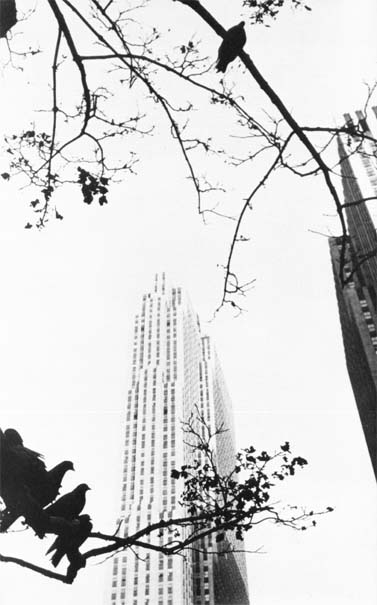 |
| RCA Building, 30 Rockefeller Plaza. |
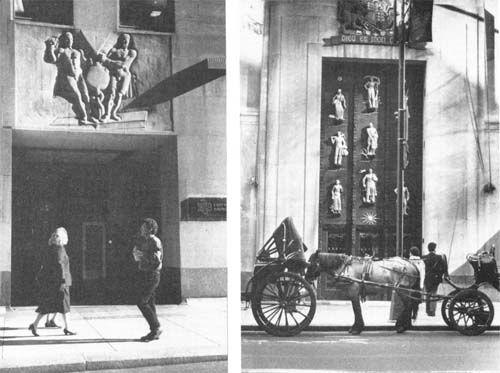 |
| Left: Sculpture over entrance, 45 Rockefeller Plaza. Right: Entrance to 620 Fifth Avenue, British Empire Building. |
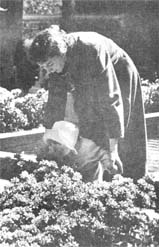 | 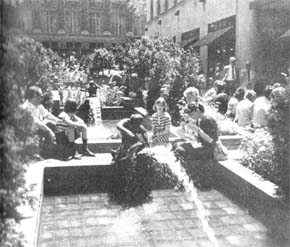 | |
| Springtime in Channel Gardens. | ||
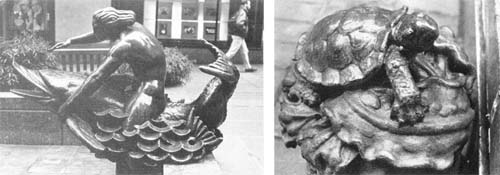 |
| Sculpture by Rene P. Chambelan at Channel Gardens. |
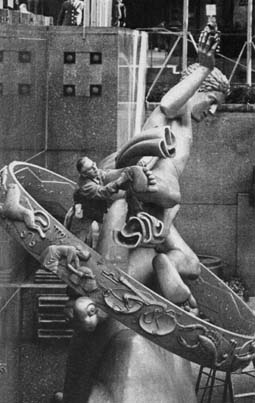
| Home | Tours/Lectures | Books | Maps | Posters | Pictures | Contact |
ROCKEFELLER CENTER
Between Fifth and Sixth Avenues at 48th to 51st Streets.
Rockefeller Center extends from West 48th Street to West 51st Street, and was built between 1931 and 1940. Reinhard & Hofmeister, Harvey Wiley Corbett, Harrison & MacMurray, Raymond Hood, Godley & Fouilhoux were the architects. This is the original Center, which leaves out the additions north of 51st Street and West of Sixth Avenue.
When completed in 1940 it was, and remains by far, the best single improvement executed in the city over the past sixty years, to be compared to the covering over of Park Avenue between 1903 and 1913.
John D. Jr. was its sole financier. Helping in the project was his son, Nelson. In fact, it was Nelson, along with the architect Wallace K. Harrison, who persuaded him to turn to the modern style instead of the classical. (It must be remembered that John D. Jr. did not like modern art.)
What made it possible was the fact that Columbia University owned most of the land encompassed by the limits of the original center. Thus when the long-term leases of the commercial buildings and houses on the site fell due, John D. Jr. obtained a lease with a renewable option. Other than sparing him the trouble of assembling hundreds of parcels, by obtaining so large a property he was able to commission a plan which could take advantage of Manhattan's grid. It must be remembered that the east-west block from 5th to 6th is 900 feet long, and the footage from 48th to 51st is 720.
What the architects devised was a form of central square between 49th and 50th Streets, with a short street on its west flank running from 48th to 51st. They placed tall buildings on three sides of the square, those to the north and south with partial setbacks, while on the east they placed two low buildings facing Fifth Avenue. Between the two low buildings was a central axis running to the square. In addition to providing symmetry and balance they obtained a central perspective from the avenue looking to the Center's highest building, the shaft which became the RCA Building. A third element was a common modern style with little relief in the form of profiles and enrichments, but with sufficient indentation to accent the vertical. And they ruled out towers, until then mandatory for high buildings, and cornices.
A last element was that the buildings were built of Indiana limestone, our most beautiful building stone, of the same color, surface and texture.
At its most effective it is to be viewed at this pause in the tour. That is to say, between the Maison Française and the British Empire Building, looking west above the Channel Cardens to 30 Rockefeller Plaza, the RCA Building. The 70-story shaft of limestone, seen beyond the square, is nicely framed by the two low buildings. This is one of the great views of the city.
Of course, the rectangular well in the center of the square is one of the city's great attractions. It is especially true in winter when the well shelters a skating rink. We are all fascinated by the spectacle of the skilled and not-so-skilled going round and round, moving spots of color on a white ground.
Because it leads to the chief attraction at the square, the Channel Gardens are often are often overlooked. They consist of six glass-bottomed basins with bronze mermen and mermaids riding spouting dolphins, the work of the sculptor René P. Chambelan. The effect is of a cascade descending to the well below.
No less important than the water are the plantings, which are changed fourteen times a year. These cover a world-wide range from desert plants to tropical flora. This is the city's most elaborate, if small, display. Easter is perhaps the best known when 800 white Madonna lilies are set out. There are also four roof gardens which encompass three acres of additional planting. In all, six full-time gardeners are at work here. It is true that we have the splendid botanical gardens and the Conservatory Gardens in Central Park, but there are no other floral displays in the center of the city. So we can be grateful for this spectacular display here.
The tour pauses at the New York Public Library on Fifth Avenue at 42nd Street, because it is one of our finest public buildings and because it is one of the great libraries of the world. Presently engaged in an ambitious fund-raising campaign headed by Dr. Vartan Gregorian, library president, the Library has received several gifts from the Rockefeller family, including a recent $2.5 million by Mr. David Rockefeller to honor Mrs. Brooke Astor. The forebears of her late husband, Vincent Astor, were among the Library's founders. Another good example of the Rockefeller family's giving is the recently-opened Gottesman Exhibition Hall where the Rockefeller Brothers Fund, Inc. gave $1 million for the hall's restoration.
On the recently restored terrace there are two pavilions where refreshments are now dispensed. The two long beds of roses at street level are maintained by the Horticultural Society of New York, a memorial to Mary W. C. Benenson. The policy of having flowerbeds here should be extended to Bryant Park at the rear of the Public Library.
The tour goes south on Fifth Avenue to Washington Square. On the south side of the square between Thompson and Sullivan Streets is the Judson Memorial Church and Judson Hall.
 |
| RCA Building, 30 Rockefeller Plaza. |
 |
| Left: Sculpture over entrance, 45 Rockefeller Plaza. Right: Entrance to 620 Fifth Avenue, British Empire Building. |
 |  | |
| Springtime in Channel Gardens. | ||
 |
| Sculpture by Rene P. Chambelan at Channel Gardens. |
